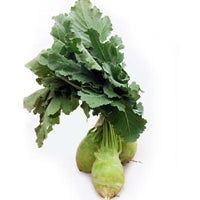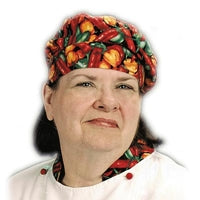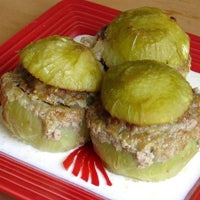Guest Chef Barbara Rolek
This month’s featured dish, a recipe for Stuffed Kohlrabi submitted by chef and freelance writer Barbara Rolek, very much represents the chef’s passion for teaching and preserving the traditional cuisines of Eastern Europe.

Kohlrabi , with its strange name and even stranger appearance, is a vegetable that most home cooks ignore in the produce department simply because not many know how to prepare it. Admittedly, this writer was a part of this group until challenged with having to try Barbara’s recipe for this article. It was definitely a learning experience that took three attempts to get right, due in part to a basic ignorance of the main ingredient as well as some western culinary habits that had to be left in the pantry, so to speak, in order to prepare the dish in the traditional style that is Eastern European cooking. Hopefully, this article will save the reader from these gringo-in-Hungary preparation mistakes.
Firstly, though the kohlrabi is to be stuffed, do not choose bulbs that are larger than a baseball. The bigger the bulb, the tougher it will be to cook and eat. Even just a half-inch larger in diameter will be the difference between serving this dish with a fork rather than a hammer and sickle, which may be very Russian but is not what is meant by Eastern European cuisine. When choosing kohlrabi, keep in mind that a single serving will consist of two bulbs, plated with room to spare on the dish, just large enough to accommodate a very moderate amount of Barbara’s tasty stuffing. The super-sized bulbs that I used in my first preparation attempt only resembled a baseball in hardness and toughness, and that was after both parboiling and baking!
Also, do not be tempted to “correct” Barbara’s recipe by browning the meat before stuffing the kohlrabi or covering the baking dish while it is in the oven. This is especially important if this recipe is being served to someone born or tracing heritage to anywhere east of the Baltic Sea. Otherwise, there is a risk of the reappearance of that hammer and sickle at your table again, only this time as weapons defending that region’s traditional cooking style. Browning the meat first and helping the bake along with a little trapped steam will definitely produce a more familiar flavor and texture to the western palate; however, as Chef Barbara ardently pointed out, it will simply NOT be an authentic Eastern European presentation and those who are knowledgeable will spot it immediately.
The process for this monthly feature always starts with the preparation of the recipe before a word is spoken to the chef or written down on paper. For this one, it was more like that story about the little blond burglar girl and the three bears. Chef Barbara’s recipe was first followed to the letter, but using kohlrabi that was simply much too large. A second batch was attempted, only this time with tweaks that this writer felt were needed to make it “better”. Finally, after a long chat with the chef, a third preparation was tried using the right ingredients and methods, plus a dash of humility. You already know the ending…it was just right!

Barbara Rolek began her culinary career working for several years in some of the best restaurants in her hometown of Chicago, until a chronic medical condition forced her to look for another way to ply her craft, or as she put it, “I was freed from the pressures of watch-your-back-cooking”, and now enjoy a much friendlier work environment that has focused on the discovery, teaching and celebration of the foods of my Eastern European roots.” To be clear, Barbara defines Eastern European as the foods and cultures of Bulgaria, Czech Republic, Croatia, Hungary, Lithuania, Poland, Romania, Russia, Serbia, Slovakia, Slovenia and Ukraine.
The recipes of Barbara’s Polish “busia” (short for babcia, meaning grandmother) turned out to be the springboard to a new career that she continues to develop through her own Joy of Eastern European Cooking web column, sponsored by About.com. She also teaches classes on this style of cooking for a local college’s culinary program and is currently developing a book series that will cover the subject, country by country.
“When I contracted lupus, I could no longer keep up the hectic schedule or, frankly, the competitive fortitude that it takes to operate a restaurant kitchen,” she explained. “I had to find another way to practice my profession and writing had always come easy for me. So I combined my talents by taking a position as the food editor and food writer for a local paper. The overwhelmingly appreciative response that I received from Chicago’s Polish community whenever I would occasionally feature the traditional recipes of my grandmother and first-generation mother encouraged me to focus my food writing on what I knew best. It was obvious that I had tapped into a desire by those who shared my heritage to rediscover or be introduced to the foods of their original homelands. As luck would have it, About.com advertised for a food writer with Eastern European expertise and my world has been filled with tasty pierogi and the like ever since!”
While it is certainly true that many of the recipes Barbara presents were probably first prepared in the rural kitchens of medieval Eastern Europe, she wants to dispel any notion that this fare consists of only basic blue collar dishes that are not appropriate for white tablecloth presentation. “Modern Polish cuisine, aka MOPO, is alive and flourishing in many upscale restaurants throughout Poland. I have also met several inventive chefs of Polish descent in this country adapting traditional ingredients and preparations to create exciting high-end dishes.”
MOPO is a rapidly expanding cooking style and another culinary project that Barbara has put on her TO DO list for gathering between the covers of a future book. “Actually, there are so many great subtopics related to the foods of Eastern Europe that I have an almost unlimited supply of writing ingredients that I expect will keep me busy for a long time to come. So far it has been a wonderful journey that has given me a much better understanding and appreciation for the foods that shaped the cultures that are at the very core of my genome. Plus, as a chef and writer, the commute between my kitchen and writing desk is the perfect distance as I am never out of range of the wonderful aromas of the foods that I write about!”
Stuffed Kohlrabi
By Chef Barbara Rolek
Serves 3 (two per person)

Ingredients:
6 medium kohlrabi
1 pound ground beef, veal, pork or lamb
1 large Perfect Sweet Onion, finely chopped
1½ tablespoons butter
2 large eggs
1 fresh organic garlic clove, finely chopped
1½ cups chicken or vegetable broth
1 cup sour cream
2 tablespoons all-purpose flour
Salt and pepper to taste
Preparation:
Parboil kohlrabi for 20 minutes. Cool until they can be handled, then peel away the tough outer skin. Cut a bit off the root end so they will stand straight up. Cut about a ½ inch off the tops and reserve. Scoop out the flesh of the bottoms and chop finely.
In a medium skillet, sauté onions and chopped kohlrabi in butter until tender. Transfer to a large bowl, and combine with raw meat, eggs, garlic, salt and pepper to taste. Preheat oven to 350°F. Coat a casserole dish with cooking spray.
Fill kohlrabi bottoms with meat mixture, place in dish and place kohlrabi tops on. Pour the broth over the kohlrabi. Bake 40-50 minutes or until tender. Remove kohlrabi to a serving platter and keep warm. Skim fat off pan juices. Blend flour into the sour cream thoroughly with a fork. Temper with a few ladles of hot pan juices, whisking constantly.
Pour tempered sour cream into pan juices and cook until thickened. Add salt and pepper to taste. Serve stuffed kohlrabi with sauce on the side or ladled over each.

Kohlrabi , with its strange name and even stranger appearance, is a vegetable that most home cooks ignore in the produce department simply because not many know how to prepare it. Admittedly, this writer was a part of this group until challenged with having to try Barbara’s recipe for this article. It was definitely a learning experience that took three attempts to get right, due in part to a basic ignorance of the main ingredient as well as some western culinary habits that had to be left in the pantry, so to speak, in order to prepare the dish in the traditional style that is Eastern European cooking. Hopefully, this article will save the reader from these gringo-in-Hungary preparation mistakes.
Firstly, though the kohlrabi is to be stuffed, do not choose bulbs that are larger than a baseball. The bigger the bulb, the tougher it will be to cook and eat. Even just a half-inch larger in diameter will be the difference between serving this dish with a fork rather than a hammer and sickle, which may be very Russian but is not what is meant by Eastern European cuisine. When choosing kohlrabi, keep in mind that a single serving will consist of two bulbs, plated with room to spare on the dish, just large enough to accommodate a very moderate amount of Barbara’s tasty stuffing. The super-sized bulbs that I used in my first preparation attempt only resembled a baseball in hardness and toughness, and that was after both parboiling and baking!
Also, do not be tempted to “correct” Barbara’s recipe by browning the meat before stuffing the kohlrabi or covering the baking dish while it is in the oven. This is especially important if this recipe is being served to someone born or tracing heritage to anywhere east of the Baltic Sea. Otherwise, there is a risk of the reappearance of that hammer and sickle at your table again, only this time as weapons defending that region’s traditional cooking style. Browning the meat first and helping the bake along with a little trapped steam will definitely produce a more familiar flavor and texture to the western palate; however, as Chef Barbara ardently pointed out, it will simply NOT be an authentic Eastern European presentation and those who are knowledgeable will spot it immediately.
The process for this monthly feature always starts with the preparation of the recipe before a word is spoken to the chef or written down on paper. For this one, it was more like that story about the little blond burglar girl and the three bears. Chef Barbara’s recipe was first followed to the letter, but using kohlrabi that was simply much too large. A second batch was attempted, only this time with tweaks that this writer felt were needed to make it “better”. Finally, after a long chat with the chef, a third preparation was tried using the right ingredients and methods, plus a dash of humility. You already know the ending…it was just right!

Barbara Rolek began her culinary career working for several years in some of the best restaurants in her hometown of Chicago, until a chronic medical condition forced her to look for another way to ply her craft, or as she put it, “I was freed from the pressures of watch-your-back-cooking”, and now enjoy a much friendlier work environment that has focused on the discovery, teaching and celebration of the foods of my Eastern European roots.” To be clear, Barbara defines Eastern European as the foods and cultures of Bulgaria, Czech Republic, Croatia, Hungary, Lithuania, Poland, Romania, Russia, Serbia, Slovakia, Slovenia and Ukraine.
The recipes of Barbara’s Polish “busia” (short for babcia, meaning grandmother) turned out to be the springboard to a new career that she continues to develop through her own Joy of Eastern European Cooking web column, sponsored by About.com. She also teaches classes on this style of cooking for a local college’s culinary program and is currently developing a book series that will cover the subject, country by country.
“When I contracted lupus, I could no longer keep up the hectic schedule or, frankly, the competitive fortitude that it takes to operate a restaurant kitchen,” she explained. “I had to find another way to practice my profession and writing had always come easy for me. So I combined my talents by taking a position as the food editor and food writer for a local paper. The overwhelmingly appreciative response that I received from Chicago’s Polish community whenever I would occasionally feature the traditional recipes of my grandmother and first-generation mother encouraged me to focus my food writing on what I knew best. It was obvious that I had tapped into a desire by those who shared my heritage to rediscover or be introduced to the foods of their original homelands. As luck would have it, About.com advertised for a food writer with Eastern European expertise and my world has been filled with tasty pierogi and the like ever since!”
While it is certainly true that many of the recipes Barbara presents were probably first prepared in the rural kitchens of medieval Eastern Europe, she wants to dispel any notion that this fare consists of only basic blue collar dishes that are not appropriate for white tablecloth presentation. “Modern Polish cuisine, aka MOPO, is alive and flourishing in many upscale restaurants throughout Poland. I have also met several inventive chefs of Polish descent in this country adapting traditional ingredients and preparations to create exciting high-end dishes.”
MOPO is a rapidly expanding cooking style and another culinary project that Barbara has put on her TO DO list for gathering between the covers of a future book. “Actually, there are so many great subtopics related to the foods of Eastern Europe that I have an almost unlimited supply of writing ingredients that I expect will keep me busy for a long time to come. So far it has been a wonderful journey that has given me a much better understanding and appreciation for the foods that shaped the cultures that are at the very core of my genome. Plus, as a chef and writer, the commute between my kitchen and writing desk is the perfect distance as I am never out of range of the wonderful aromas of the foods that I write about!”
Stuffed Kohlrabi
By Chef Barbara Rolek
Serves 3 (two per person)

Ingredients:
6 medium kohlrabi
1 pound ground beef, veal, pork or lamb
1 large Perfect Sweet Onion, finely chopped
1½ tablespoons butter
2 large eggs
1 fresh organic garlic clove, finely chopped
1½ cups chicken or vegetable broth
1 cup sour cream
2 tablespoons all-purpose flour
Salt and pepper to taste
Preparation:
Parboil kohlrabi for 20 minutes. Cool until they can be handled, then peel away the tough outer skin. Cut a bit off the root end so they will stand straight up. Cut about a ½ inch off the tops and reserve. Scoop out the flesh of the bottoms and chop finely.
In a medium skillet, sauté onions and chopped kohlrabi in butter until tender. Transfer to a large bowl, and combine with raw meat, eggs, garlic, salt and pepper to taste. Preheat oven to 350°F. Coat a casserole dish with cooking spray.
Fill kohlrabi bottoms with meat mixture, place in dish and place kohlrabi tops on. Pour the broth over the kohlrabi. Bake 40-50 minutes or until tender. Remove kohlrabi to a serving platter and keep warm. Skim fat off pan juices. Blend flour into the sour cream thoroughly with a fork. Temper with a few ladles of hot pan juices, whisking constantly.
Pour tempered sour cream into pan juices and cook until thickened. Add salt and pepper to taste. Serve stuffed kohlrabi with sauce on the side or ladled over each.


Leave a comment